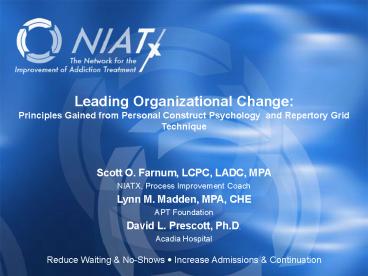Leading Organizational Change: - PowerPoint PPT Presentation
1 / 14
Title:
Leading Organizational Change:
Description:
Principles Gained from Personal Construct Psychology and ... Mahatma Gandhi. Reduce Waiting & No-Shows Increase Admissions & Continuation. www.NIATx.net ... – PowerPoint PPT presentation
Number of Views:334
Avg rating:3.0/5.0
Title: Leading Organizational Change:
1
Leading Organizational Change Principles Gained
from Personal Construct Psychology and Repertory
Grid Technique
Scott O. Farnum, LCPC, LADC, MPA NIATX, Process
Improvement Coach Lynn M. Madden, MPA, CHE APT
Foundation David L. Prescott, Ph.D. Acadia
Hospital
Reduce Waiting No-Shows ? Increase Admissions
Continuation
2
NIATx Aims
- Reduce Waiting Times
- Reduce No-Shows
- Increase Admissions
- Increase Continuation Rates
3
Leaders Create and Organize the Team
- Send a letter of invitation
- Let the Board know what you are doing, and the
names of the team members - Publicize your results good or not so good
- Show up
4
Mechanics of Leadership
- Schedule regular meetings
- Make sure the data is up to date
- Be in the thick of the work share knowledge and
authority - Interact with coaches
- Guide the selection of projects
- Show up
5
NIATX LEADERSHIP ACADEMY
- Three important Domains Self, Community and
Enterprise - In relation to Strategy continual self an org.
leadership abilities - People building the structure to support change
- Execution Defining objectives/plans
- Results Achieving improved org
6
- You must be the change you wish to see in the
world. - Mahatma Gandhi
7
George Kelly, the Creator of Repertory Grids
8
- A good deal is said these days about being
oneself. It is supposed to be healthy to be
oneself. While it is a little hard for me to
understand how one could be anything else, I
suppose what is meant is that one should not
strive to become anything other than what he is.
This strikes me as a very dull way of living in
fact, I would be inclined to argue that all of us
would be better off if we set out to be something
other than what we are. Well, Im not so sure we
would all be better off - perhaps it would be
more accurate to say life would be a lot more
interesting. - George Kelly, The Language of Hypothesis, 1964
9
Basis Tenets of Repertory Grid Technique
- 1.) The elicitation of elements identifying
the things in the arena to be
investigated. - 2.) The elicitation of constructs identifying
the distinctions that can be made among these
elements. - 3.) The construction of a grid of elements and
constructs.
10
- Personal Construct
- A personal construct is a bipolar dimension
which each person has created and formed into a
system of thought through which they interpret
their experiences of the world. - Element
- People, things, or events which elicit
constructs. - Repertory Grid
- A method for exploring personal construct
systems and an attempt to stand in others
shoes, see the world as they see it, and
understand their situations and concerns.
11
Common Grid Elements
- a teacher you liked
- a teacher you disliked
- significant other
- difficult employer/supervisor
- well liked supervisor
- your mother
- your father
- brother nearest in age
- sister nearest in age
- well liked co-worker
- difficult co-worker
- person you feel sorry for
- most successful person you know
- most intelligent person you know
- most interesting person you know
- a boy who did not like you in high school
- a girl who did not like you in high school
12
Exercise Instructions
- 1.) Write the provided elements in the 8 slots
along the top of the grid - 2.) In the first 2 lines of the grid place an x
in the 3 spaces corresponding to the provided
numbers - 3.) Next place numbered index cards face down
- 4.) Shuffle the cards
- 5.) Randomly select 3 cards
- 6.) Turn the 3 cards over and place an x in the
third grid line corresponding to the 3 selected
numbers - 7.) Return the selected cards to the pile of
index cards - 8.) Repeat this procedure until all 8 lines are
completed - 9.) Then decide for each line of the grid, Out
of the 3 elements chosen, which 2 seem to have
something more in common with each other? - 10.) Connect these two elements with a line
- 11.) On the left side of the grid describe what
aspect these 2 elements share - 12.) One the right side express what makes the
3rd element different
13
Exercise Elements
- 1.) Financial Stability
- 2.) Organizational Change
- 3.) Me
- 4.) Co-workers
- 5.) Organizational Culture
- 6.) Typical Supervisor
- 7.) Me ideal
- 8.) Office of Substance Abuse
14
Resources
- http//www.brint.com/PCT.htm
- http//www.enquirewithin.co.nz/
- http//repgrid.com/
- http//www.eac-leipzig.de/scivescoweb/
- The Psychology of Personal Constructs, George
Kelly, 1955 - A Manual for Repertory Grid Technique, Fay
Fransella, Richard Bell Don Bannister, 2004





![[PDF] Handbook of Organizational Creativity Kindle PowerPoint PPT Presentation](https://s3.amazonaws.com/images.powershow.com/10080790.th0.jpg?_=20240718031)

























